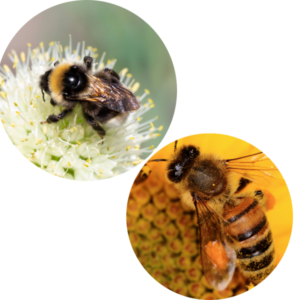When you’re visiting the Milwaukee County Zoo this summer, you just might see some honeybees buzzing about the Zoo grounds. A new colony of bees was installed at the Zoo in April, and while around 7,000 bees were brought in from a local Wisconsin bee supplier, Auriana Donaldson, conservation manager, says that at the colony’s peak it could reach a population of roughly 100,000!
So in celebration of World Bee Day, here are some fun facts that you might not know about bees!
All bees are the same, right? Wrong!
According to the USGS, there are over 20,000 different species of bees in the world, with 4,000 of them having a range in the United States. Much like the flowers they pollinate, bees can come in many sizes, shapes and colors.
Fun Fact: Honeybees are not native to the United States! They originated in Europe, Asia and Africa, and over the years were transported to Australia and North and South America. Now they play an important role in our agriculture as pollinators!
Some people may use the names honeybee and bumble bee interchangeably, however they are two very different types of bees! Honeybees are skinnier in appearance — looking closer to the shape of a wasp — and have smaller stripes. Bumblebees, meanwhile, are larger and look fuzzier, with thicker black and yellow stripes.
Donaldson says that the behaviors from honeybees and bumble bees are different as well. Honeybees will produce honey in excess, and during the winter they will form a buzzing structure around their queen — using the warmth from their buzzing to keep her alive through the cold months.
Bumble bees, however, only make enough honey to feed on, and during the winter months the entire colony will die off with the exception of the queen, which will go into hibernation in our backyards and green spaces.

Bee calm and buzz on
Typically, honeybees will leave you alone if you leave them alone, says Donaldson. They will be too busy buzzing about pollinating plants and looking for food. So don’t be worried if you see one flying by. Just stand back and give it a friendly wave to thank it for its hard work!
Bee our guest: Make your backyard a great home for bees
Bees of all shapes and sizes are important to the health of our ecosystem! Their role as key pollinators helps the plants and flowers all around us grow and thrive. That’s why it’s important to make your backyard a safe and welcoming area for these VIBs — Very Important Bugs! Try a few of these suggestions to support the bees:
- Plant flowering resources — including native pollinator-friendly plants
- Reduce pesticide use in your yard
- Leave holes created by other animals untouched — those make great homes for bumble bees!
If you have a bumble bee nest in your backyard, consider yourself lucky! They only nest in a location for one season before the queen bumble bee finds a new home each spring to start a new colony.
Donaldson says you should contact conservation@zoosociety.org if you have a bumble bee nest in your backyard — researchers would love to study these nests to learn more about bumble bee ecology!
